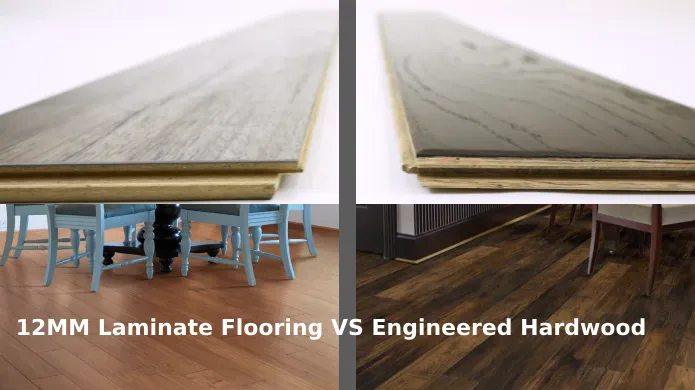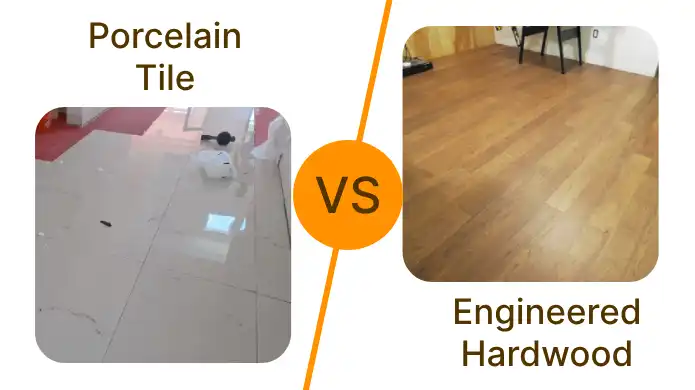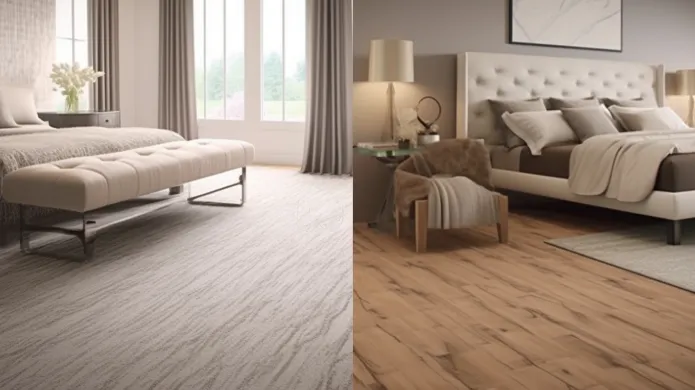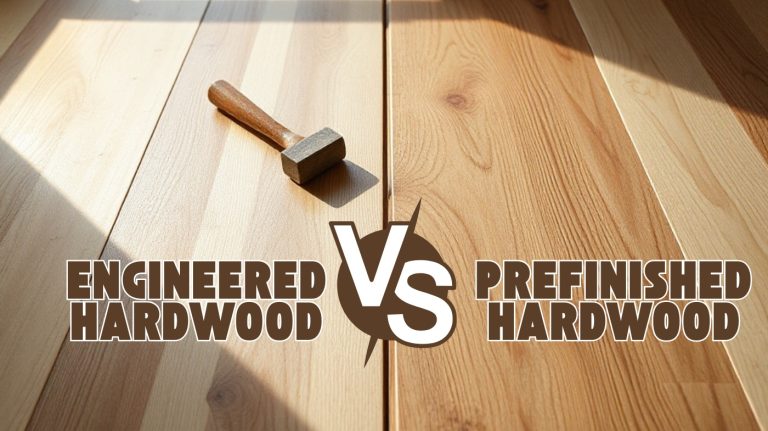If you have hardwood floors in your home, you know how important it is to keep them clean and well-maintained. But when it comes to cleaning, you may be wondering whether it’s better to sweep or vacuum your hardwood floors.
When it comes to cleaning hardwood floors, you have two main options: sweeping or vacuuming. Sweeping is a simple and effective way to remove dirt and debris from your floors. But, vacuuming can provide a deeper clean, especially when it comes to removing pet hair and dust.
Here, we’ll take a closer look at the pros and cons of sweeping and vacuuming hardwood floors, as well as provide tips on how to do each effectively. Whether you’re a seasoned homeowner or a first-time renter, you’ll gain valuable insight into the best methods for keeping your hardwood floors looking their best.
So, let’s get started!
How Do You Sweep or Vacuum Hardwood Floors?
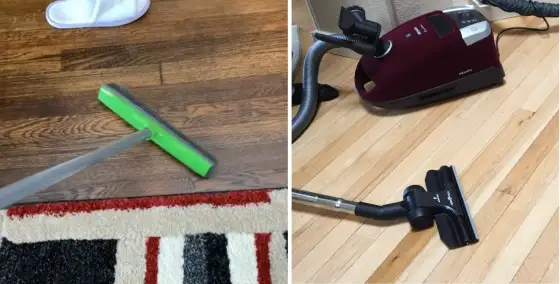
Whether you’re sweeping or vacuuming your floors, the process is fairly straightforward. Here are the steps you’ll need to take for each:
- Sweep Hardwood Floors
Sweeping hardwood floors with a broom is a quick and effective way to remove debris and keep the surface clean. For best results, follow these tips:
1. Start by clearing the floor of any large debris or obstacles that may damage the broom or the floor.
2. Hold the broom at a comfortable angle and use long, smooth strokes to sweep from one end of the room to the other.
3. Make sure to reach into corners and along the baseboards, and don’t forget to sweep between floorboards where dust and dirt can accumulate.
4. If necessary, use the broom bristles to dislodge and sweep away any trapped debris.
Remember to gather the swept dirt and debris into a dustpan and dispose of it in a waste bin. For optimal cleanliness, you can also follow up with a damp mop or a microfiber cloth to wipe away any remaining dust.
- Vacuum Hardwood Floors
Using a vacuum cleaner with the appropriate attachment and suction settings can effectively remove dirt and debris from wooden surfaces. It doesn’t just save time and effort compared to sweeping, it also prevents scratches or damage to the floor.
- When vacuuming a hardwood floor, it’s important to remove any large debris or objects beforehand and attach a soft-bristled brush or hardwood floor accessory to the vacuum. This will ensure that the vacuum doesn’t scratch or damage the floor surface.
- To effectively vacuum a hardwood floor, start from one end of the room and work your way to the other end in a back-and-forth motion, overlapping each pass slightly. Pay special attention to areas along the baseboards, corners, and under furniture where dust and dirt tend to accumulate.
- If your vacuum cleaner has attachments for crevices or corners, use them to clean hard-to-reach areas. Once you’ve finished vacuuming, empty the canister or replace the bag, and clean or wash any attachments used.
- You may also follow up vacuuming with a damp mop or use a hardwood floor cleaner to remove any remaining stains or dirt.
By following these simple steps, you can effectively clean a hardwood floor without damaging it.
Pros and Cons of Sweeping Hardwood Floors
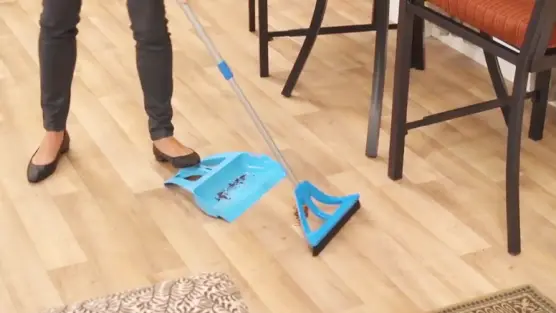
Brooms are like the unsung heroes of hardwood floor cleaning. They offer cost-effective and gentle cleaning while reaching tight spaces and allowing for quiet operation. With a broom, you can easily sweep away debris and dirt from your hardwood floors without the need for electricity or maintenance.
However, it’s important to keep in mind that sweeping may not effectively capture fine dust particles, which can lead to residual dust on the floor surface. Sweeping also requires physical exertion and continuous manual effort to cover the entire floor area.
Furthermore, sweeping can sometimes stir up dust and cause it to settle elsewhere in the room, potentially affecting air quality. Lastly, brooms may struggle to dislodge and remove embedded dirt, pet hair, or larger debris from the floor surface.
Despite these drawbacks, sweeping remains a cost-effective and efficient way to maintain the cleanliness and longevity of your hardwood floors.
Pros and Cons of Vacuuming Hardwood Floors
Get ready to experience a spotless and effortless clean with the advantages and disadvantages of using a vacuum on your beautiful wooden surfaces. With its powerful suction capabilities and versatile attachments, vacuuming is an efficient way to clean hardwood floors.
Not only is it time-efficient, but it also provides a deeper clean by extracting dirt from cracks and corners. Additionally, vacuuming with proper filtration systems can reduce airborne dust, making it a great option for individuals with allergies or respiratory sensitivities.
Regular vacuuming can also potentially extend the lifespan of your hardwood floors by removing abrasive particles that can wear down the finish.
However, there are a few drawbacks to vacuuming hardwood floors. Care must be taken when selecting attachments or models with rotating brush bars to avoid scratching or damaging the floor finish.
Additionally, some vacuum cleaners can be heavy and difficult to maneuver, making it challenging to clean larger areas or move between levels. Dependence on electricity and maintenance requirements, such as cleaning filters or replacing bags, can also be a consideration.
Finally, vacuum cleaners may require more storage space compared to brooms, so it’s essential to consider available storage options before purchasing.
Comparison Table between Sweeping and Vacuuming Hardwood Floors
| Criteria | Sweeping | Vacuuming |
| Method | Manual | Mechanical |
| Efficiency | Less effective for fine dust | More effective for dirt and debris |
| Reachability | Limited in tight spaces | Can reach corners and hard-to-reach areas |
| Labor Intensity | Requires physical exertion | Less physically demanding |
| Dust Dispersion | May disperse dust in the air | Can contain and trap dust with proper filtration |
| Allergy-friendly | Potential to stir up dust | Can reduce airborne dust with proper filtration |
| Versatility | Primarily for floors | Can clean floors, carpets, and other surfaces |
| Maintenance | Minimal | May require periodic maintenance (emptying canister, cleaning filters) |
| Pet Hair Removal | May not capture all pet hair | Efficient in picking up pet hair |
| Time Efficiency | Time-consuming | Faster cleaning method |
How often should you vacuum hardwood floors?

For optimal cleanliness and maintenance, it’s recommended to vacuum your hardwood surfaces at least once or twice a week, depending on various factors such as the amount of foot traffic and the presence of pets.
Regular vacuuming helps to remove dirt, dust, and debris from your floors, preventing them from scratching or damaging the surface. Additionally, vacuuming can also help to improve indoor air quality by removing allergens and other pollutants.
However, it’s important to note that excessive vacuuming can also damage your hardwood floors, especially if you’re using a vacuum with a beater bar or rotating brush. These types of vacuums can scratch the surface of your floors, causing them to look dull and worn over time.
To avoid this, make sure to use a vacuum with a soft-bristled brush attachment or switch to a microfiber mop or broom for regular cleaning. Ultimately, the key is to strike a balance between regular cleaning and gentle maintenance to keep your hardwood floors looking their best for years to come.
What is the best method to sweep the hardwood floor?
To maintain the cleanliness of your hardwood surfaces and limit dust, try sweeping toward yourself in short, smooth motions, starting from the corners and using a dustpan frequently to avoid spreading dirt and debris.
This method helps control the pile of debris and prevents excessive dust from rising up into the air. Sweeping in the opposite direction can create a cloud of dust that’ll settle back onto the floor, leaving it looking dirty and dull.
Here are a few tips to help you get the most out of your sweeping routine:
- Use a high-quality broom made specifically for hardwood floors. This’ll help you pick up more dirt and debris with each sweep, saving you time and effort.
- Sweep your floors at least once a week to keep them looking their best. If you’ve pets or a high-traffic area, you may need to sweep more often.
- Consider using a microfiber dust mop to pick up any remaining dirt and debris after sweeping. This’ll help you achieve a more thorough clean and’ll leave your floors looking shiny and new.
Regularly Maintaining Your Hardwood Floors with Sweeping or Vacuuming
Maintaining the appearance and longevity of your hardwood floors is crucial. It’s recommended by experts to vacuum at least once a week. However, families with pets and kids may need to vacuum more frequently to keep up with their messes.
While both techniques: sweeping and vacuuming have their own advantages and disadvantages, personal preference plays a significant role in choosing the method. Whether you decide to sweep or vacuum, make sure to use a soft-bristled brush or attachment to prevent any scratches on the wood.
By following these guidelines, you can keep your hardwood floors looking new for years. Remember, there’s no better feeling than walking on fresh and immaculate wooden floors.



